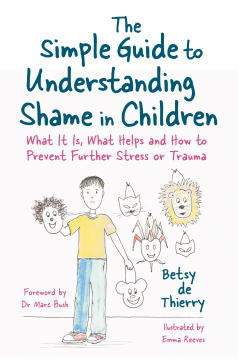
Additional Information
Book Details
Abstract
· What is shame?
· How does it affect children?
· How can adults help?
The perfect starting point for any adult or carer working with children who have experienced shame, this guide provides straightforward answers and explanations to both common and complex questions.
At a time when children are more likely than ever to experience shame, the accessible advice in this book helps adults to boost children's self-esteem. Betsy de Thierry navigates the need to understand its impact and the reasons behind it, as well as how to reduce its hold on self-confidence. Reassuring advice will also help revitalize adults' abilities to face the challenges of supporting children affected by shame. It will teach them how to restore self-esteem.
Betsy de Thierry is a mum of four brilliant boys, a practising psychotherapist, a qualified primary school teacher, and founder of two organisations that offer therapy and therapeutic education in many cities in the UK. She lives in Bath.
Table of Contents
| Section Title | Page | Action | Price |
|---|---|---|---|
| The Simple Guide to Understanding Shame in Children by Betsy de Thierry | 1 | ||
| Foreword | 6 | ||
| Preface | 9 | ||
| Ch 1. What is Shame? | 13 | ||
| The difference between shame and guilt | 16 | ||
| Shaming | 18 | ||
| What does shame feel like? | 20 | ||
| Shame exists on a continuum | 22 | ||
| Overcoming shame | 27 | ||
| Social attitudes to shame | 29 | ||
| Reflection points | 30 | ||
| Ch 2. The Impact of Shame | 31 | ||
| Humans need to belong | 31 | ||
| The body’s response to shame | 32 | ||
| Problems caused by coping mechanisms | 34 | ||
| Reflection points | 41 | ||
| Ch 3. The Neuroscience of Shame | 42 | ||
| The threat response – digging deeper | 42 | ||
| Shame in toddlers | 44 | ||
| When you can’t fight or flee | 45 | ||
| Shame as a tool to stay safe | 48 | ||
| The problem with trying to remember or talk about past shame experiences | 49 | ||
| The impact of toxic shame can be minimalized when an adult is empathetic and kind | 50 | ||
| Reflection points | 51 | ||
| Ch 4. Sources of Shame | 52 | ||
| Parenting techniques | 53 | ||
| Abuse, neglect, secret family problems | 55 | ||
| Online peer pressure | 57 | ||
| Being compared | 57 | ||
| Having your needs dismissed | 58 | ||
| Self-blame | 59 | ||
| Shame used to silence victims | 60 | ||
| Expectation of being perfect | 61 | ||
| Confusing boundaries | 61 | ||
| Adolescence | 62 | ||
| School systems that shame children | 62 | ||
| Religious influence | 64 | ||
| Reflection points | 65 | ||
| Ch 5. Shame Symptoms: When Children Withdraw | 66 | ||
| Running away, hiding or becoming silent | 66 | ||
| Loneliness and withdrawing emotionally | 67 | ||
| Apologizing continually | 68 | ||
| Wearing masks | 69 | ||
| Compliance and fear of risk-taking | 71 | ||
| Reflection points | 72 | ||
| Ch 6. Shame Symptoms: When Children Deceive or Blame | 73 | ||
| Lying | 73 | ||
| Deceit | 74 | ||
| Being critical of others and projection | 74 | ||
| Reflection points | 77 | ||
| Ch 7. Shame Symptoms: When Children Hate Themselves | 78 | ||
| Anger | 79 | ||
| Self-destructive behaviours | 80 | ||
| Reflection points | 82 | ||
| Ch 8. Shame Symptoms: When Children Shut Down or Dissociate | 83 | ||
| Emotional shut-down | 83 | ||
| Dissociation | 85 | ||
| Addiction | 86 | ||
| Reflection points | 87 | ||
| Ch 9. Overcoming Shame | 88 | ||
| Provide healing emotional connection with the child | 89 | ||
| Tips for emotional connection with a child or young person | 90 | ||
| Understanding normal human behaviour | 91 | ||
| Speak up for cultures of vulnerability and kindness | 92 | ||
| Help wake up the child’s frontal lobes! | 93 | ||
| Self-compassion | 94 | ||
| Reflection points | 95 | ||
| Ch 10. Shame Resilience and Healing | 96 | ||
| Ten ways to promote healing from shame | 97 | ||
| Beware perfection! | 99 | ||
| How to help when a child’s behaviour shows shame-based coping mechanisms | 100 | ||
| Top tips on how to respond to a crying or angry child | 101 | ||
| Praising children for their good character, wise decisions and gifts | 102 | ||
| Conclusion | 103 | ||
| Reflection points | 103 | ||
| References and Recommended Reading | 104 | ||
| Index | 106 |
